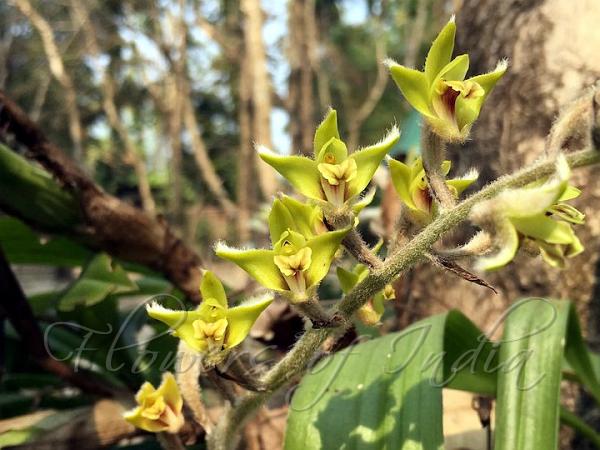|
| Woolly Eria |
|

|

| File size | 140728 |
| Original date | 2/28/17 10:03 AM |
| Resolution | 800 x 1067 |
| Flash | Flash did not fire, auto |
| Focal length | 4.15mm |
| Exposure time | 1/503s |
| Aperture | 2.2 |
| Focus Distance | |
| Metering Mode | Spot |
| Camera make | Apple |
| Camera model | iPhone 6s |
| Sensor type | OneChipColorArea |
|
|
|
|
Photo: |
Botanical name: Dendrolirium lasiopetalum Family: Orchidaceae (Orchid family)
Synonyms: Eria lasiopetala, Eria flava, Eria lanata, Eria pubescens
Synonyms: Eria lasiopetala, Eria flava, Eria lanata, Eria pubescens
Woolly Eria is an orchid found growing on trees, with
creeping rhizome, about 5 mm in diameter. Flower racemes are 10-20 cm
long, laxly flowered; axis densely white or grayish yellowish
cottony-hairy. Petals are linear, about 14 x 1 mm, tapering; lip ovate
in outline, about 11 x 5 mm, base contracted into a claw, 3-lobed;
margins of lobes wavy; lateral lobes obovate; mid-lobe oblong; disk
with an obovate-lanceshaped thickened area extending from base to
mid-lobe. Column about 4 mm, thick, foot about 4 mm, arcuate. Sepals
are densely white or grayish yellowish cottony-hairy below; dorsal
sepal lanceshaped, about 12 x 2 mm, blunt; lateral sepals
triangular-lanceshaped, slightly oblique, about 13 x 5 mm. Floral
bracts ovate-lanceshaped, about 1 cm, below with white or grayish
yellowish cottony hairs, tip long tapering; flower-stalk and ovary 2-3
cm, densely hairy. Pseudobulbs are borne 1.5-5 cm apart on rhizome,
spindle-shaped, 3-7.5 x 1.5-3.5 cm, tip with 3-5 leaves. Leaves are
elliptic or oblong-lanceshaped, 12-30 x 1.5-5 cm, with 8-14 main veins,
tip tapering. Capsule is cylindric, 2.5-4 cm x about 4 mm, with white
cottony hairs when young. Woolly Eria is found in forests, on trees
along streams, and on rocks, at altitudes of 1200-1700 m, in China,
Bhutan, Cambodia, India, Laos, Myanmar, Nepal, Thailand, Vietnam.
Flowering: January-April.
| Identification credit: Khyanjeet Gogoi, Nayan Jyoti Gogoi | Photographed in Assam. |
• Is this flower misidentified? If yes,